The zinc transporter ZnT3 interacts with AP-3 and it is preferentially targeted to a distinct synaptic vesicle subpopulation
- PMID: 14657250
- PMCID: PMC329249
- DOI: 10.1091/mbc.e03-06-0401
The zinc transporter ZnT3 interacts with AP-3 and it is preferentially targeted to a distinct synaptic vesicle subpopulation
Abstract
Synaptic vesicles (SV) are generated by two different mechanisms, one AP-2 dependent and one AP-3 dependent. It has been uncertain, however, whether these mechanisms generate SV that differ in molecular composition. We explored this hypothesis by analyzing the targeting of ZnT3 and synaptophysin both to PC12 synaptic-like microvesicles (SLMV) as well as SV isolated from wild-type and AP-3-deficient mocha brains. ZnT3 cytosolic tail interacted selectively with AP-3 in cell-free assays. Accordingly, pharmacological disruption of either AP-2- or AP-3-dependent SLMV biogenesis preferentially reduced synaptophysin or ZnT3 targeting, respectively; suggesting that these antigens were concentrated in different vesicles. As predicted, immuno-isolated SLMV revealed that ZnT3 and synaptophysin were enriched in different vesicle populations. Likewise, morphological and biochemical analyses in hippocampal neurons indicated that these two antigens were also present in distinct but overlapping domains. ZnT3 SV content was reduced in AP-3-deficient neurons, but synaptophysin was not altered in the AP-3 null background. Our evidence indicates that neuroendocrine cells assemble molecularly heterogeneous SV and suggests that this diversity could contribute to the functional variety of synapses.
Figures
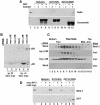
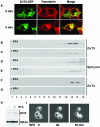
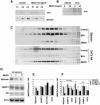

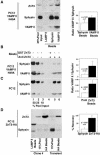


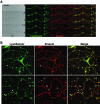
Similar articles
-
AP-3-dependent mechanisms control the targeting of a chloride channel (ClC-3) in neuronal and non-neuronal cells.J Biol Chem. 2004 Jun 11;279(24):25430-9. doi: 10.1074/jbc.M402331200. Epub 2004 Apr 8. J Biol Chem. 2004. PMID: 15073168
-
Dependence of the histofluorescently reactive zinc pool on zinc transporter-3 in the normal brain.Brain Res. 2011 Oct 18;1418:12-22. doi: 10.1016/j.brainres.2011.08.055. Epub 2011 Aug 27. Brain Res. 2011. PMID: 21911210
-
Aberrant trafficking of the high-affinity choline transporter in AP-3-deficient mice.Eur J Neurosci. 2008 Jun;27(12):3109-17. doi: 10.1111/j.1460-9568.2008.06268.x. Epub 2008 Jun 1. Eur J Neurosci. 2008. PMID: 18554297
-
What is the function of neuronal AP-3?Biol Cell. 2007 Jul;99(7):349-61. doi: 10.1042/BC20070029. Biol Cell. 2007. PMID: 17567262 Review.
-
Neuronal and non-neuronal functions of the AP-3 sorting machinery.J Cell Sci. 2007 Feb 15;120(Pt 4):531-41. doi: 10.1242/jcs.03365. J Cell Sci. 2007. PMID: 17287392 Review.
Cited by
-
Loss of AP-3 function affects spontaneous and evoked release at hippocampal mossy fiber synapses.Proc Natl Acad Sci U S A. 2006 Oct 31;103(44):16562-7. doi: 10.1073/pnas.0603511103. Epub 2006 Oct 20. Proc Natl Acad Sci U S A. 2006. PMID: 17056716 Free PMC article.
-
Adaptor protein-3 complex is required for Vangl2 trafficking and planar cell polarity of the inner ear.Mol Biol Cell. 2019 Aug 15;30(18):2422-2434. doi: 10.1091/mbc.E16-08-0592. Epub 2019 Jul 3. Mol Biol Cell. 2019. PMID: 31268833 Free PMC article.
-
Presynaptic membrane retrieval and endosome biology: defining molecularly heterogeneous synaptic vesicles.Cold Spring Harb Perspect Biol. 2013 Oct 1;5(10):a016915. doi: 10.1101/cshperspect.a016915. Cold Spring Harb Perspect Biol. 2013. PMID: 24086045 Free PMC article. Review.
-
Biogenesis of zinc storage granules in Drosophila melanogaster.J Exp Biol. 2018 Mar 19;221(Pt 6):jeb168419. doi: 10.1242/jeb.168419. J Exp Biol. 2018. PMID: 29367274 Free PMC article.
-
Is zinc a neuromodulator?Sci Signal. 2008 May 13;1(19):re3. doi: 10.1126/stke.119re3. Sci Signal. 2008. PMID: 18480018 Free PMC article. Review.
References
-
- Atwood, H.L., and Karunanithi, S. (2002). Diversification of synaptic strength: presynaptic elements. Nat. Rev. Neurosci. 3, 497-516. - PubMed
-
- Bellocchio, E.E., Reimer, R.J., Fremeau, R.T., Jr., and Edwards, R.H. (2000). Uptake of glutamate into synaptic vesicles by an inorganic phosphate transporter. Science 289, 957-960. - PubMed
Publication types
MeSH terms
Substances
Grants and funding
LinkOut - more resources
Full Text Sources
Research Materials

